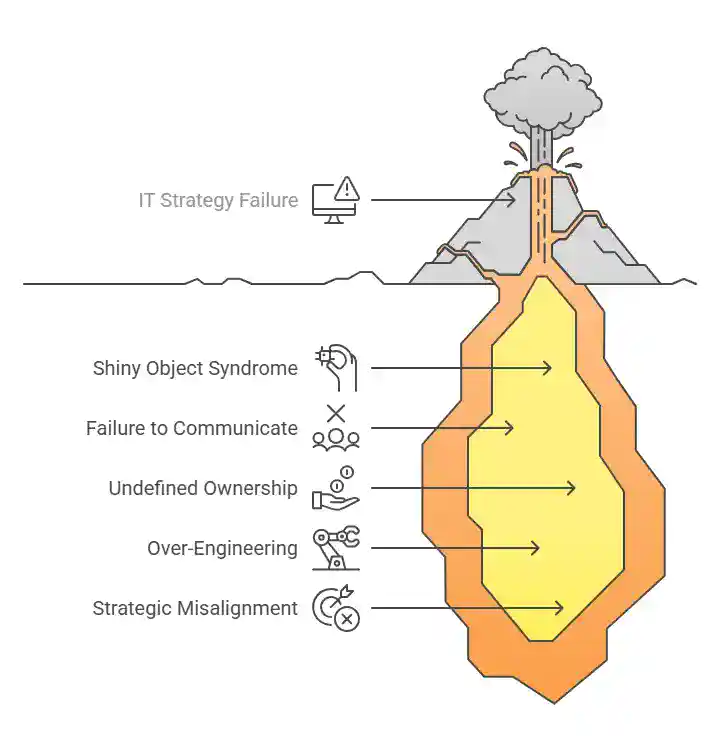Technology has become central to economic competition. But many small and mid-sized businesses (SMBs) still operate with outdated or reactive IT approaches. The result? Misaligned investments, operational inefficiencies, and stalled growth.
According to a McKinsey report, 70% of digital transformation efforts fail to deliver their intended value. Why? A lack of strategic alignment between business goals and IT execution.
“In 2025, strategy-driven IT will be the defining edge between SMBs that scale and those that stall.” – Ethan Gillani, CEO of Micro-Tech USA
This guide delivers a straightforward, executive-level approach to developing IT strategy—empowering you to make confident technology decisions, minimize operational risks, and position your business for sustainable growth.
Turn Uncertainty Into Clarity with a Strategic IT Plan
Partner with Micro-Tech USA for Expert-Guided IT Consulting That Drives Real Results
Understand What an IT Strategy Is—and What It’s Not
Too many businesses mistake IT strategy for a shopping list of tools or a set of one-off tech projects. A strong IT strategy is a comprehensive business enabler—a clearly defined framework that guides how your technology investments support long-term organizational goals.
Let’s break this down:
- An IT Strategy defines the vision, direction, and priorities for how IT will support the broader business. It lays the foundation for every technology-related decision, ensuring that infrastructure, software, and services all drive measurable business value.
- An IT Roadmap, on the other hand, is the implementation timeline—a tactical plan detailing how and when various components of the strategy will be rolled out. Think of it as the itinerary for a strategic journey.
- Digital Transformation refers to the broader cultural, operational, and customer-facing changes driven by adopting digital tools and processes. An IT strategy often powers and directs this transformation, but they are not the same.
A robust IT strategy is not just a CIO’s document—it’s a leadership asset. It should articulate the “why” behind your IT decisions and serve as a playbook for aligning systems, people, and priorities.
If your IT plan doesn’t directly address business outcomes—such as growth, agility, risk reduction, or efficiency—it’s not a strategy; it’s an expense list.
Strategic Planning: Start With the Business, Not the Technology
An effective IT strategy always starts with the business in mind. Unfortunately, many SMBs fall into the trap of letting technology dictate their operations, chasing the latest tool or reacting to short-term problems without a long-term plan.
Instead, flip the script and begin by asking:
- What are our core business objectives over the next 12–24 months?
- Example: Entering new markets, reducing operational costs, and improving customer experience
- What measurable outcomes will indicate success?
- These become your Key Performance Indicators (KPIs)
- What technology capabilities do we need to support those goals?
- This might include systems automation, CRM tools, cloud scalability, or remote collaboration platforms
For instance, if your business aims to reduce service response times by 30%, your IT strategy might include deploying ticket automation tools, revamping internal communication systems, and integrating analytics dashboards to track performance.
Technology for technology’s sake leads to waste. Technology aligned with business goals leads to growth.
Future-Proofing Your IT: Build for Agility, Not Just Longevity
Trying to anticipate every trend in technology is a losing game. Instead of chasing predictions, focus on building an adaptable IT environment that evolves with your business and keeps you prepared for unexpected shifts.
A future-proof IT development strategy is built on:
- Cloud-first architecture: Platforms like Microsoft Azure or AWS offer flexibility, scalability, and reduced capital investment
- Open APIs and integration-ready systems: Enables seamless communication between tools and reduces vendor lock-in
- Cybersecurity baked into every layer: A proactive, zero-trust model reduces risk and increases resilience
- Vendor optionality and modular design: Gives you the ability to pivot without scrapping your entire tech stack
Strategic insight: Resilience matters more than prediction. Build IT environments that bend without breaking.
Example: Instead of investing in a rigid on-premise ERP, a growing firm might deploy a cloud-based modular ERP system that integrates with third-party logistics and sales tools, giving them room to expand or pivot quickly.
Budget with Intention: Turn IT from a Cost Center into a Growth Lever
When IT budgeting is treated as a technical exercise instead of a strategic one, it often leads to underinvestment in critical areas or overspending on nonessential tools. Smart leaders approach IT budgets as growth, innovation, and risk mitigation investments.
Key concepts to apply:
- CapEx (Capital Expenditures): Long-term infrastructure investments (e.g., servers, hardware)
- OpEx (Operating Expenses): Recurring expenses for services (e.g., cloud subscriptions, MSP support)
High-impact budgets prioritize:
- Technologies that reduce manual labor or error rates
- Systems that unlock new revenue streams or market access
- Scalable tools that won’t require constant reinvestment
Every dollar spent on IT should be tied to a measurable business outcome—whether that’s efficiency, compliance, or competitive advantage.
Validate spending using Total Cost of Ownership (TCO) and Return on Investment (ROI) calculations, and revisit budgets quarterly to remain aligned with business shifts.
| Learn More About How Small Businesses Can Stay Ahead of Issues |
Give IT a Seat at the Leadership Table
Technology is no longer just a support function—it’s a strategic asset. Yet in many SMBs, IT decision-making is still reactive, disconnected from the leadership team, and delegated without strategic oversight.
This creates three problems:
- Technology lacks direction
- Leadership lacks visibility
- Strategic initiatives underperform
To fix this, IT should be treated as a core business function, not a utility.
Practical steps:
- Involve your IT lead (internal or vCIO) in quarterly planning and board-level reviews
- Establish shared terminology and reporting dashboards so IT and business leaders speak the same language
- Set expectations for IT accountability just like any other strategic function
When IT isn’t represented at the table, you end up building strategy on a wobbly foundation.
By integrating IT leadership early and often, you create alignment, foster innovation, and avoid unnecessary rework.
From Strategy to Execution: Operationalize with Precision
Having a strategy on paper isn’t enough. Execution requires focus, coordination, and systems for follow-through. One of the biggest challenges in implementing IT strategy is prioritization, especially for resource-limited SMBs.
Use proven frameworks:
- MoSCoW Prioritization: Classify actions as Must-have, Should-have, Could-have, or Won’t-have
- Eisenhower Matrix: Categorize initiatives by urgency and importance to eliminate noise
Set rolling 30–90 day sprints with defined goals, clear owners, and built-in accountability. Incorporate agile principles to adapt when business needs shift.
Where MSPs shine: A trusted Managed Service Provider like Micro-Tech USA can offer strategic support, manage vendor negotiations, track KPIs, and ensure technical tasks don’t get lost in the shuffle.
89% of companies that initiate transformation efforts hit integration roadblocks. Execution is where strategy goes to thrive or die. The most brilliant plans mean little if they’re not implemented with discipline.
Costly Missteps to Avoid
Even well-intentioned IT strategies can stumble. Keep these common mistakes on your radar:
- Shiny Object Syndrome: Avoid investing in tools without a clearly defined use case
- Failure to Communicate: Underestimating change management leads to poor adoption
- Undefined Ownership: If no one owns execution, momentum fades
- Over-Engineering: Complex systems often go unused or cause friction
One of the most overlooked but critical elements of IT strategy execution is training. Without proper user education and change management, even the most advanced systems will go underutilized or misapplied. Employees must be equipped not only with the tools but also with the knowledge and confidence to use them effectively.
The most common cause of IT failure is strategic misalignment, not poor technology.

Quick-Glance: Your IT Strategy Development Checklist
| Step | Action | Value |
| 1 | Clarify business goals | Ensures IT serves growth objectives |
| 2 | Audit current systems | Identify risk and opportunity areas |
| 3 | Define tech priorities | Aligns tools to business needs |
| 4 | Build the roadmap | Brings structure and accountability |
| 5 | Assign leadership roles | Eliminates ambiguity |
| 6 | Budget strategically | Enables execution without financial friction |
| 7 | Execute + optimize | Keeps momentum and relevance |
Let Micro-Tech USA Turn Your IT Strategy Into a Business Advantage
Creating an effective IT strategy isn’t just about choosing the right tools. It’s about making intentional decisions that strengthen your business. That’s where Micro-Tech USA comes in.
As a seasoned managed IT services provider, Micro-Tech USA partners with growth-minded businesses to align technology with long-term vision. From strategic planning to hands-on execution, we help you avoid costly detours—and stay on the path to scalable success.
Ready to develop an IT strategy that drives results? Schedule your strategy consultation now.
| Find Proactive IT Support in The Midwest | |
| Chicago | Milwaukee |








